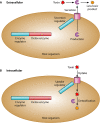Current and Emerging Tools of Computational Biology To Improve the Detoxification of Mycotoxins
- PMID: 34878810
- PMCID: PMC8824263
- DOI: 10.1128/AEM.02102-21
Current and Emerging Tools of Computational Biology To Improve the Detoxification of Mycotoxins
Abstract
Biological organisms carry a rich potential for removing toxins from our environment, but identifying suitable candidates and improving them remain challenging. We explore the use of computational tools to discover strains and enzymes that detoxify harmful compounds. In particular, we focus on mycotoxins-fungus-produced toxins that contaminate food and feed-and biological enzymes that are capable of rendering them less harmful. We discuss the use of established and novel computational tools to complement existing empirical data in three directions: discovering the prospect of detoxification among underexplored organisms, finding important cellular processes that contribute to detoxification, and improving the performance of detoxifying enzymes. We hope to create a synergistic conversation between researchers in computational biology and those in the bioremediation field. We showcase open bioremediation questions where computational researchers can contribute and highlight relevant existing and emerging computational tools that could benefit bioremediation researchers.
Keywords: biodegradation; bioinformatics; bioremediation; computational biology; enzymes; exoenzymes; mycotoxins; toxins.
Conflict of interest statement
The authors declare no conflict of interest.
Figures
Similar articles
-
Review of mycotoxin reduction in food and feed: from prevention in the field to detoxification by adsorption or transformation.Food Addit Contam Part A Chem Anal Control Expo Risk Assess. 2011 Nov;28(11):1590-609. doi: 10.1080/19440049.2011.595377. Epub 2011 Jul 20. Food Addit Contam Part A Chem Anal Control Expo Risk Assess. 2011. PMID: 21770849 Review.
-
Microbiological Detoxification of Mycotoxins: Focus on Mechanisms and Advances.Infect Disord Drug Targets. 2021;21(3):339-357. doi: 10.2174/1871526520666200616145150. Infect Disord Drug Targets. 2021. PMID: 32543365 Review.
-
Improvement of the enzymatic detoxification activity towards mycotoxins through structure-based engineering.Biotechnol Adv. 2022 May-Jun;56:107927. doi: 10.1016/j.biotechadv.2022.107927. Epub 2022 Feb 16. Biotechnol Adv. 2022. PMID: 35182727 Review.
-
Detoxification of Mycotoxins through Biotransformation.Toxins (Basel). 2020 Feb 14;12(2):121. doi: 10.3390/toxins12020121. Toxins (Basel). 2020. PMID: 32075201 Free PMC article. Review.
-
Combinations of emerging technologies with fermentation: Interaction effects for detoxification of mycotoxins?Food Res Int. 2021 Mar;141:110104. doi: 10.1016/j.foodres.2021.110104. Epub 2021 Jan 5. Food Res Int. 2021. PMID: 33641971 Review.
Cited by
-
Partner-assisted artificial selection of a secondary function for efficient bioremediation.iScience. 2023 Aug 16;26(9):107632. doi: 10.1016/j.isci.2023.107632. eCollection 2023 Sep 15. iScience. 2023. PMID: 37694149 Free PMC article.
-
Comprehensive Review of Aflatoxin and Ochratoxin A Dynamics: Emergence, Toxicological Impact, and Advanced Control Strategies.Foods. 2024 Jun 18;13(12):1920. doi: 10.3390/foods13121920. Foods. 2024. PMID: 38928866 Free PMC article. Review.
-
Starch can expedite the screening for bacterial aflatoxin degraders.Sci Rep. 2024 Dec 30;14(1):31961. doi: 10.1038/s41598-024-83511-3. Sci Rep. 2024. PMID: 39738442 Free PMC article.
-
Luminescent Bacteria as Bioindicators in Screening and Selection of Enzymes Detoxifying Various Mycotoxins.Sensors (Basel). 2024 Jan 24;24(3):763. doi: 10.3390/s24030763. Sensors (Basel). 2024. PMID: 38339480 Free PMC article.
-
Microbial detoxification of mycotoxins in food.Front Microbiol. 2022 Nov 23;13:957148. doi: 10.3389/fmicb.2022.957148. eCollection 2022. Front Microbiol. 2022. PMID: 36504774 Free PMC article. Review.
References
-
- Kebede H, Liu X, Jin J, Xing F. 2020. Current status of major mycotoxins contamination in food and feed in Africa. Food Control 110:106975. 10.1016/j.foodcont.2019.106975. - DOI
-
- Edite Bezerra da Rocha M, da Chagas Oliveira Freire F, Erlan Feitosa Maia F, Izabel Florindo Guedes M, Rondina D. 2014. Mycotoxins and their effects on human and animal health. Food Control 36:159–165. 10.1016/j.foodcont.2013.08.021. - DOI
Publication types
MeSH terms
Substances
LinkOut - more resources
Full Text Sources



